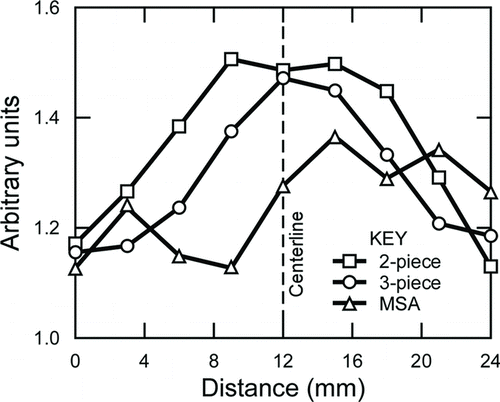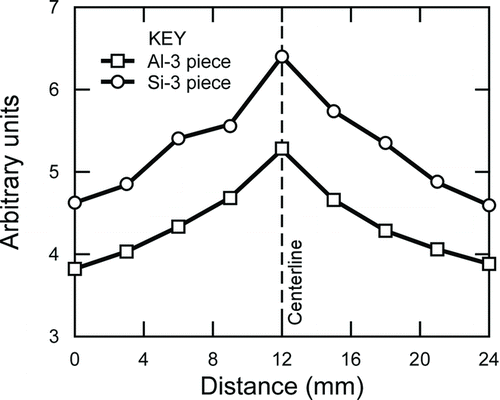Abstract
Miners are exposed to silica-bearing dust which can lead to silicosis, a potentially fatal lung disease. Currently, airborne silica is measured by collecting filter samples and sending them to a laboratory for analysis. Since this may take weeks, a field method is needed to inform decisions aimed at reducing exposures. This study investigates a field-portable Fourier transform infrared (FTIR) method for end-of-shift (EOS) measurement of silica on filter samples. Since the method entails localized analyses, spatial uniformity of dust deposition can affect accuracy and repeatability. The study, therefore, assesses the influence of radial deposition uniformity on the accuracy of the method. Using laboratory-generated Minusil and coal dusts and three different types of sampling systems, multiple sets of filter samples were prepared. All samples were collected in pairs to create parallel sets for training and validation. Silica was measured by FTIR at nine locations across the face of each filter and the data analyzed using a multiple regression analysis technique that compared various models for predicting silica mass on the filters using different numbers of “analysis shots.” It was shown that deposition uniformity is independent of particle type (kaolin vs. silica), which suggests the role of aerodynamic separation is negligible. Results also reflected the correlation between the location and number of shots versus the predictive accuracy of the models. The coefficient of variation (CV) for the models when predicting mass of validation samples was 4%–51% depending on the number of points analyzed and the type of sampler used, which affected the uniformity of radial deposition on the filters. It was shown that using a single shot at the center of the filter yielded predictivity adequate for a field method, (93% return, CV approximately 15%) for samples collected with 3-piece cassettes.
Copyright 2013 American Association for Aerosol Research
1. INTRODUCTION
The National Institute for Occupational Safety and Health (NIOSH) is investigating technologies for field-portable measurement of silica on filter samples of mine dust. That work is motivated by the fact that inhalation of excessive amounts of dust containing particles of crystalline silica can cause scar tissue to form in the lungs, which reduces their ability to extract oxygen from the air (DHHS(NIOSH) Citation1974). This condition is called silicosis, which is a disabling, irreversible and sometimes fatal lung disease. Each year, more than 250 American workers die with silicosis (NIOSH Citation2012) and many of the deaths occur in the mining industry (Bang et al. Citation2008). Despite extensive knowledge regarding silicosis prevention (Cecala et al. Citation2012), exposures are still common and have recently been linked to a resurgence of coal workers’ pneumoconiosis (CWP) (Antao et al. Citation2005; Laney and Attfield Citation2009; Suarthana et al. Citation2011).
The quantification of airborne silica has been studied previously with the goal of developing standard methods for determining worker exposures to silica-bearing dusts. Previous work focused on developing methods for in-laboratory analysis of filter samples taken in the field (Freedman et al. Citation1974; Ojima Citation2003; Ainsworth Citation2005). Miners’ exposure to silica is currently determined in the United States by collecting a filter sample and submitting it to the Mine Safety and Health Administration (MSHA), where it is analyzed by one of two methods. If from a coal mine, the analysis entails an ashing and Fourier transform infrared (FTIR) process known as the P7 analytical method (MSHA Citation2008), while samples from noncoal mines are analyzed using an X-ray diffraction technique (MSHA Citation1999). Since these methods entail a time lag of weeks before exposure data are received, the information is often of little use to inform modifications to workplace conditions aimed at preventing overexposures.
It has recently been shown that a field-portable FTIR spectrometer could be used for relatively accurate analysis of filter samples, with potential for use as an end-of-shift (EOS) method (Miller et al. Citation2012). The limitations of such field-portable methods are that they are usually less sensitive than laboratory methods and are also not capable of analyzing the entire amount of material on the filter, but rather depend on localized measurements or “shots” that include only a small portion of the filter area (Chen et al. Citation2010; Miller et al. Citation2012). It is desirable that a potential EOS method produces results that are as close to the laboratory method as possible, while keeping the analytical method simple and easy to use in the field. A portable method for filter sample analysis should thus optimally entail a minimal number of “shots,” where the shots are located to achieve adequate accuracy of predicting total silica mass on the filter. Thus, the ideal field method would be analysis of a single shot at a location chosen to achieve the accuracy required. The method must also be able to predict the total mass at different levels of dust loading, which is known to affect the “deposition profile” across the filter.
The analysis of silica directly on collection media has been previously investigated (Freedman et al. Citation1974; Kohyama and Kurimori Citation1996; HSE Citation2005; Miller et al. Citation2012). Because it is well known that filter samples are often not uniformly loaded (Foster and Walker Citation1984; Morley et al. Citation1999; Harper et al. Citation2004), this study aims to determine how the nonuniformity of dust deposition will influence the accuracy of a portable method. In the study, findings are applied to measurements made with an FTIR spectrometer but are expected to be relevant to other portable methods as well.
The issue of spatial uniformity of filter deposition was assessed previously in conjunction with evaluation of analytical protocols for asbestos (Lai et al. Citation2006). There are many factors that affect spatial uniformity, some caused by particle deposition mechanisms including impaction, interception, settling, and electrostatics. Spatial deposition of particles may also depend on the design of the sampling system including factors such as flow rate, standoff distance between the flow inlet and the filter face (Vincent Citation1989; Baron et al. Citation1994; EPA Citation2008), or the design of the filter backing plate, especially when “channels” are incorporated into the filter backing plate to help distribute the flow across the filter (Jenkins et al. Citation1992). Closed face cassettes have been shown to sometimes result in heavy center-loading (Harper et al. Citation2004). This can be considerably lessened when a cyclone preselector is used (Foster and Walker Citation1984), but the design of some cyclone-based samplers has been shown to strongly affect the results of on-filter analyses (Chen et al. Citation2010; Pretorius Citation2011). It is therefore difficult to extrapolate results derived from different sampling trains. Additionally, the effect of filter loading can be to increase the localized pressure drop across the filter media, which in turn changes the airflow pattern and influences deposition.
While variability of dust deposition is expected to be the primary source of error for on-filter analysis via portable methods, other factors that may affect the results include variability in total deposition surface area (Noll et al. Citation2005), edge effects (Foster and Walker Citation1984), or design of the backing plate that helps distribute the pressure across the filter (Jenkins et al. Citation1992). There is also the possibility that various constituents of the dust may have separated aerodynamically or that some larger particles will have penetrated the cyclone (Lee et al. Citation2010) and deposited preferentially (by impaction) near the center of the filter (Harper et al. Citation2004), potentially leading to a slight particle size dependence that could affect mass distribution as well as FTIR results (Foster and Walker Citation1984; Page Citation2003).
This article summarizes a study designed to determine the effect of deposition uniformity on the accuracy of potential field methods for filter sample analysis. The study was primarily focused on determining how the style of sampling cassette and total dust loading contribute to uneven radial deposition of dust particles on filter samples. In order to demonstrate how nonuniform deposition would affect the ability of a field-portable method to predict total mass on the filter from localized measurements, the study included measurement of silica at multiple locations on filter samples of coal dust using a field-portable FTIR spectrometer. The data from these measurements were used to develop models that predicted total mass on the filter based on data from one or more measurement locations.
2. METHODS
For this study, filter samples of Min-U-Sil 5 (henceforth referred to as Minusil) and coal dusts were generated in a Marple chamber using three different types of sampling trains, and multiple sets of filter samples were collected at five different dust loadings. Silica was measured by FTIR at nine locations across the face of each filter and the data analyzed by a multiple regression analysis (MRA) technique using statistical analysis software, which employed varying numbers of FTIR data points to predict the total mass on the filters. Results of the MRA were used to compare the accuracy of various models (each employing different numbers of data points or “analysis shots”) for predicting total dust mass on the filters.
The study was designed to limit the number of variables by using the same sampling conditions that might be used for field applications. Sampling setups, therefore, employed Dorr-Oliver cyclone preselectors, and critical orifice flow controllers were used to maintain the flow rates used in typical field samplers. All samples for the study were collected onto preweighed 37-mm polyvinylchloride (PVC) filters with 5-micron pore size (SKC® Corp., Inc.). Three types of 37-mm plastic sample cassettes were chosen; 3-piece, 2-piece, and the approved (MSA/Zefon) tamper-proof cassettes used for respirable dust sampling in coal mines. Using standard convention, the flow rate for the 2- and 3-piece cassettes was 1.7 lpm, and for the MSA cassettes 2.0 lpm.
All three types have inlet and exit nipples located on center. The MSA cassettes have the shortest inner distance between inlet and outlet (8 mm), and the largest inner diameter of the inlet (5 mm). The filter is suspended between the inlet and outlet, together with a perforated backing pad, with the filter surface approximately 4 mm from the inlet. The 2-piece cassettes have a 9-mm inner distance and a 4-mm inlet diameter, while the 3-piece cassettes have an 18-mm inner distance and a 4-mm inlet. For both 2- and 3-piece cassettes, the filter and backing pad lie on a plastic backing plate directly over the outlet and the air-flow is pulled through small channels or “spokes” in the plastic plate. The only difference between both 2- and 3-piece cassettes is the distance from the inlet to the filter surface (8 mm for the 2-piece and 17 mm for the 3-piece). Since all three cassette types are radially symmetric in design, with inlet and outlet on center, the analysis of deposition uniformity in the following sections was based on the assumption of radial symmetry.
2.1. Filter Sample Preparation
Two types of dust were chosen for the study. For preliminary tests, a standard silica reference material (Minusil) was chosen, having a relative purity of 92% (Stacy et al. Citation2009). The coal dust chosen for the study was derived from the Pittsburgh coal seam and ground to a target mean diameter of 4 microns. It has been characterized previously (Volkwein et al. Citation2004a) and contains approximately 5.5% silica. More importantly, the silica content is constant for this well-characterized, homogenous source of coal dust, allowing for the correlation of FTIR data with total dust mass as was done in this study.
Filter samples with known amounts of coal dust and Minusil were prepared in a manner published previously (Miller et al. Citation2012). The dusts were aerosolized in a Marple chamber and collected onto preweighed 37-mm PVC filters placed in each of the three different cassette types. The filter loadings were approximately in the range of 100–500 μg for Minusil and 250–3500 μg for coal dust. After collection, all filter samples were post-weighed to determine the loaded mass of dust. Sets of samples were prepared that included two filter samples (one for training and one for validation) loaded at five different target mass loadings for a total of 10 samples per set, plus three blanks. Three sample sets (one for each of the three cassette types), were prepared for both coal and Minusil, for a total of six sets.
2.2. Sample Analysis: FTIR
FTIR spectrometry entails illumination of the sample with multiwavelength radiation using an IR-emitting source and an interferometer. For the technique used in this study, the IR beam is directed through the filter samples (a process referred to as transmission mode). The beam interacts with the sample, which absorbs certain wavelengths of radiation, and the transmitted radiation is collected by a detector and processed using a Fourier transform algorithm, generating an “absorbance spectrum” (Griffiths and de Haseth Citation1986). The number of different wavelengths generated by the interferometer determines the resolution of the spectrum, which is proportional to the path length of the movable mirror in the interferometer. The absorbance spectrum shows as to which wavelengths have been absorbed by unique molecular bonds in the sample, and can thus be used to quantify compounds containing those bonds. Since the scan time is relatively short, the FTIR instrument typically conducts multiple sequential scans, and the data from all scans are analyzed and averaged to reduce noise in the data.
The FTIR spectrometer chosen for this study (Bruker Optics, model Alpha) was designed for field portability and is capable of quantifying silica deposited on filters in the range of 25–200 μg (Miller et al. Citation2012). In the Miller et al. study, the spectrometer was calibrated using filter samples with known masses of a standard crystalline silica reference material deposited onto filters. Such empirical calibration has been shown to be repeatable if conducted carefully (DHHS(NIOSH) Citation1974). The resolution of the FTIR can be adjusted by setting the path length of the mirror. For this study, the resolution was set to 4 cm−1, which has been shown previously to reduce noise (Tuchman Citation1992) while still providing adequate peak identification and maintaining a reasonably quick sampling time.
The method used for analyzing filter samples with the FTIR instrument entailed mounting the filter in a stainless steel holder that was placed so that the filter was centered between the horizontal IR source beam and the detector, where the beam has a 6-mm focal diameter. The holder was vertically adjustable in 3-mm increments to allow repeatable analyses at nine locations across the centerline of the filter. For the first shot, the holder was placed so that the beam intersected the filter 12 mm from the center. Subsequent shots were taken at 3-mm intervals (center-to-center overlap of the 6-mm beam), with the fifth shot at the filter center. At each location, the IR beam was turned on for the time required to complete 40 scans, determined by experimentation to be an adequate amount of sampling time to ensure both a dependable signal-to-noise ratio and shot-to-shot repeatability (Miller et al. Citation2012).
Prior to analyzing the Minusil or coal samples, scans of the atmosphere and of the blank filter were run so that they could be subtracted from the resulting silica and coal spectra. This was done using the manufacturer's software, and was necessary to accurately quantify the silica peak. After the subtraction is performed, the remaining spectra relates only to the Minusil or coal that was on the filters.
For each shot, an absorbance spectrum was generated and saved for analysis. Silica presented in the spectra as doublet peaks between 816 cm−1 and 767 cm−1 and that region was therefore integrated for all spectra to give an area (in arbitrary units) representing the relative mass of silica at each of the nine locations on the samples.
When measuring silica in coal dust using FTIR, it is usually necessary to correct for interference by kaolin (Anderson Citation1983; Ojima Citation2003; MSHA Citation2008). This is done by measuring the main kaolin peak at approximately 915 cm−1 and using it along with a correction scheme to adjust the value of the silica doublet peak (Ainsworth Citation2005; Miller et al. Citation2012). However, in this study, while the main kaolin peak was quantified (to investigate the potential for a kaolin-specific deposition pattern), the correction was not applied to the silica measurement. Instead, the raw value of the silica doublet peak was correlated directly to the gravimetric mass of the sample. The reasoning for this was to eliminate potential errors in the data due to kaolin correction itself, since our goal was to study the influence of only deposition uniformity on the accuracy of using the FTIR method to predict total mass on the filter.
Since kaolin correction will be applied to eventual field measurements of silica, it is important to know whether there is a pattern in the deposition of silica-rich or kaolin-rich particles. To ascertain this, the deposition profiles of both silica and kaolin measurements were assessed independently.
2.3. Sample Analysis: EDS
To verify the accuracy and repeatability of the FTIR measurements, a subset of the Minusil and coal-dust samples were analyzed by energy-dispersive X-ray spectroscopy (EDS). An Oxford EDS system was used installed on an FEI Nova NanoSEM 230 Scanning Electron Microscope (SEM). Accelerating voltage was set to 20 kV and the spot size setting was 3.5.
In preparation for analysis, the filters were mounted onto 37-mm stubs using carbon tape and sputter-coated with a 10-nm layer of gold. The stubs were placed on the self-centering stage of the SEM and the detector set at a working distance of 5 mm. The magnification was set so that the EDS scan region was a 3-mm wide rectangle. Scan time was set to 20 s and the detector recorded and stored 2000 channels of data in the energy range from 0 to 20 keV.
For the sample subset, EDS analyses were done at the same nine locations across each filter as for FTIR. During preliminary testing, it was found that the deposition profiles have a relatively uniform radial pattern but with some minor variations, depending on the orientation of the filter during analysis. For this reason, a reference point specified as “top” was marked on all filters so that both FTIR and EDS analyses would be taken at identical locations across the filters. At each location, a spectrum was generated that showed the relative abundance of Si, Al, and Cl as markers for silica (SiO2), kaolin (Al2Si2O5(OH)4), and filter background (PVC), respectively. These data were imported into a spreadsheet and used to generate deposition profiles for each element. In addition to verifying the accuracy and repeatability of the FTIR measurements, these data were also used to evaluate the potential for constituent-specific deposition bias.
2.4. Data Processing
The most important goal of this work was to quantify the relative accuracy of predicting total filter loading using single versus multiple localized FTIR analyses on a filter. This was accomplished by comparing predictive models that estimate total filter deposition using FTIR data taken at one or more representative locations on the filter. Such data from sets of samples were analyzed using a statistical approach to calculate how the choice of number and location of the measurements affect the accuracy of prediction when the FTIR-measured data from limited and isolated locations are extrapolated to predict the total mass on the filter.
A variety of models have been used previously for estimating total filter deposition from measurements at localized points, including models based on two points (EPA Citation2008), three points (Morley et al. Citation1999), as well as area-weighted and distance-weighted locations (Lai et al. Citation2006). The method chosen for this study entailed comparing models that incorporated one-to-four radially unique points, and performing a multiple regression analysis with no intercept (Morley et al. Citation1999) on each FTIR dataset, using statistical analysis software (SAS Institute, Cary, NC), with the total gravimetric mass of the filter sample as the independent variable. The raw FTIR instrument readings in arbitrary units were regressed against the known gravimetric mass in μg/filter. No correction for the surface area analyzed was necessary since the regression develops a predictive relationship between the instrument readings and the gravimetric mass. It is also assumed that the amount of silica and kaolin in the dust is constant, which is a reasonable assumption for this well-characterized dust (Volkwein et al. Citation2004b).
Best-fit coefficients were determined for four-, three-, two-, and one-point predictive models according to the following equation:
(1) where α1 to α4 = coefficients for the four different models (number of coefficients will match the number of locations used in the model), and A–D are the measured peak areas at each of the locations used in the regression (i.e., at the 3-mm-spaced locations on the filter). Half of the 10 samples in each set were used as a training set, and the results of EquationEquation (1)
(1) for the various model types were compared to the gravimetric masses of the samples in order to develop calibrations (best fit coefficients) using the various models. The calibrations were then used to predict the mass of the validation samples to determine the most appropriate model.
The center measurement was expected to be different from the other positions, which would confirm the nonuniform deposition expected from closed-face cassette sampling. The locations that are radially equidistant from the center were not expected to be different from each other (p value greater than 0.05), which would indicate radial symmetry of deposition.
The model results (predicted filter loading) were regressed against gravimetric filter loading and the slopes, intercepts, and Pearson correlation coefficients assessed. To analyze the relative accuracy of each model across the five different filter loadings, the percent return (predicted mass divided by gravimetric mass times 100%) was calculated for each filter sample and averaged for the set of five samples. That averaged value along with the five individual values was used to calculate a relative standard deviation (or coefficient of variation, CV) for each set of five samples.
3. RESULTS AND DISCUSSION
3.1. Filter Deposition: Silica
As a baseline for the study, and in order to avoid potential errors due to issues such as the presence of kaolin, other potential confounders, or deposition bias of the constituents of coal dust, we first studied deposition of pure silica (Minusil) on filters. Deposition profiles derived from FTIR analyses of Minusil samples at the nine locations across the filters indicate that the loading on the filters collected with 3-piece and 2-piece cassettes is predictably center-heavy and radially symmetric, while deposition on filters collected with the MSA cassettes is less predictable and less symmetric (). While the shapes of the profiles for the 2- and 3-piece cassettes were found to be somewhat radially symmetric, that symmetry varied slightly, indicating that the filters are each loaded slightly differently. To better see trends (smooth out the sample-to-sample variation) in the profiles, data at all five loadings were averaged for the graph in . It is notable that while the standoff distance to the filter is shortest for the MSA cassettes (4 mm), compared to 8 mm and 17 mm for the 2- and 3-piece cassettes, there is no evidence of center-weighted deposition due to impaction as might be expected. This suggests that the center-weighted loading observed with the other two cassettes may be more a function of face velocity and pressure drop than of particle size and inertial impaction. While the variation in mass per unit area across the filters is relatively great for the 2- and 3-piece cassettes, the repeatability of the eccentricity of that deposition profile is more important for purposes of predictivity (Foster and Walker Citation1984), as will be demonstrated in the next section.
3.2. Filter Deposition: Coal
Since the “pressure drop profile” across the filter was expected to change with filter loading, the FTIR data for silica analysis of the (more heavily loaded) coal samples were analyzed next. The results showed that the deposition profiles do change slightly as filter loading increases (). Note that the data in have been normalized using the “top-most” data point to allow for easier comparison of the different loadings. For the 2-piece cassettes (), it is apparent that as the center portions of the filters become more heavily loaded, the localized pressure drop increases and the loading shifts toward the outer regions, flattening the profile slightly. This effect is absent for the MSA cassettes due to the unique backing plate design that allows broader distribution of the pressure drop across the filter, and nearly so for the 3-piece cassettes, which may be attributed to the better distribution of pressure in 3-piece cassettes due to the larger plenum volume.
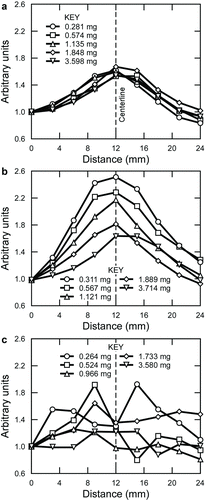
The averaged profiles for silica measurements in the coal dust samples by FTIR were normalized for ease of comparison to those of silicon by EDS (). The validity of this comparison is based on the fact that the rim of each filter was marked with a reference point to insure that analyses by FTIR and EDS were done at the same locations. It is notable that while profiles for the MSA cassettes tend to mirror each other (indicating that the two measurement methods yield similar results), the EDS profiles for the 2- and 3-piece cassettes both suggest a pattern that is not evident in the FTIR data. This pattern appears to have derived from the design of the backing plate for those cassettes, which has a 2-mm-wide channel or “trench” located approximately 6 mm from the center (Jenkins et al. 1992). Since the FTIR analytical region (6-mm-diameter spot) is larger than the EDS scan region (3 × 3 mm rectangle), it does not reflect this localized deposition anomaly. It is notable that such a deposition anomaly has the potential to adversely affect on-filter analytical methods that employ highly localized measurements. The high reading at the 9-mm location for the MSA cassette data is an example of another localized anomaly, but in this case it is unique to this dataset and reflects random variations in localized deposition, as suggested in .
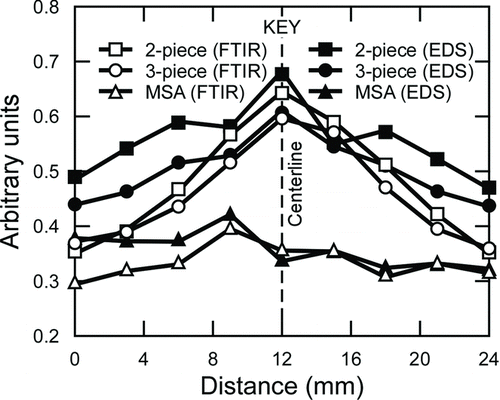
The three main constituents of dust in a coal-mine atmosphere are typically coal, silica, and kaolin (Anderson Citation1983; Schatzel Citation2009). While data regarding the relative particle size and morphology of these constituents is limited, it is generally assumed that they are well mixed, making each coal dust unique from the perspective of particle size distribution and elemental composition (Schatzel Citation2009). This being the case, it is sometimes assumed that individual constituents will not separate aerodynamically during collection. To evaluate the possibility of a compound or constituent-specific pattern in the material deposition, the averaged deposition profiles for both kaolin and (kaolin-corrected) silica in coal-dust samples (3-piece data only) were compared. The comparison suggests that no discernible constituent-dependent deposition is occurring in 3-piece cassettes for the coal dust used in this study ().
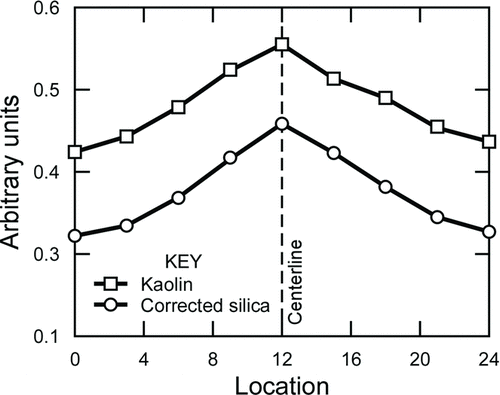
To further confirm the lack of constituent-dependent deposition, the samples used to generate were subsequently analyzed by EDS. The resulting deposition profiles showing relative abundance of Al and Si across the filters, representing markers for silica and kaolin, were compared (), and the comparisons indicate strong correlation between the deposition profiles for the two elements, similar to those above for FTIR.
3.3. Effect of Deposition on Predictivity of Mass Loading Using Coal Dust
The radial symmetry of profiles for the 2- and 3-piece cassette data and the random deposition of dust on the MSA cassette samples both support the assumption that a statistical model needs only to include radially unique points. We, therefore, limited our assessment to predictive models that took into account one to four radially unique points located at 3-mm increments from the center to the periphery. Using data from each of the (one to four) unique locations on sets of five filters (five loadings), multiple regression models were created, with the total gravimetric loading as the independent variable. Results from the various models indicate that using more data points is not significantly advantageous, and that the accuracy of prediction (reflected by the % return) for all data sets and all models varied from about 75% to 125%. For brevity, results from only a few selected models are presented ().
Table 1 TABLE 1 Compiled data (average of all five loadings) from selected predictive models based on the multiple regression analysis technique
The CV values for multiple models with the same number of points were used to calculate an average CV value, representative of models with that number of points, and a standard deviation based on the multiple CV values. The relation between precision of prediction (CV) and number of points used for the models () suggests that multiple-point models do not give significantly better precision. Since the models represent a best-fit for the five different loadings, a key factor affecting accuracy and precision of predictability is the potential for variation of deposition with filter loading. It is notable that the CVs for the MSA cassettes are highest, reflective of the randomness of the deposition evident in . The CVs for the 3-piece cassette data are the most consistent, judging by the trend in the CVs using different models (). The CVs for the 2-piece cassettes vary slightly more than those for the 3-piece cassettes, which may be related to the fact that the FTIR data for the coal dust () indicate that the 2-piece cassettes have the most variability in eccentricity of the deposition profile with increased loading.
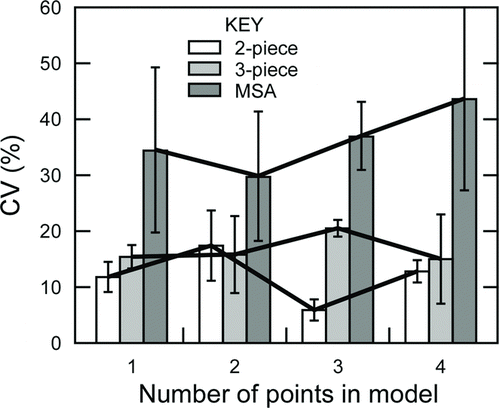
It is visually apparent () that the profiles for 2- and 3-piece cassettes are radially symmetric, but with some variation from sample to sample, which would be expected to introduce some error in the predictability of the various models. With this in mind, we assessed the single-point models using data from the center and each of the four radially unique locations. For all locations except the center shot, data from the two radially symmetric points were averaged. It was found that for the 2- and 3-piece cassettes, the CV had a very slight increasing trend for locations away from the center point (), while for the MSA filters, the CV followed no trend. It is expected that other samples would follow the trends suggested by this limited dataset, suggesting that a single shot in the center of the filter would provide necessary precision for a field method when using 2- or 3-piece cassettes. Judging by the upper bound of the error for the dataset of , single-point models for the 3-cassettes types would be expected to yield coefficients of variation less than about 18% for 3-piece, 15% for 2-piece, and 50% for MSA cassettes.
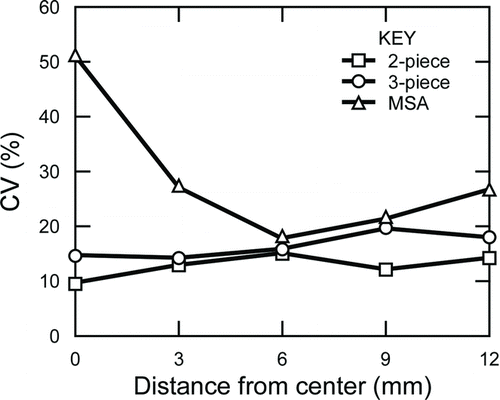
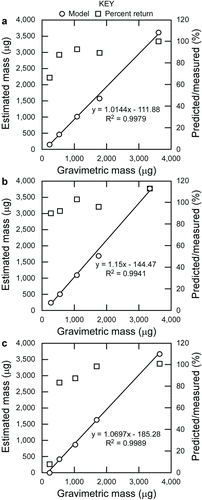
Results from multiple regression analyses of single FTIR shots taken at multiple locations on coal dust samples from the three different types of cassettes (training samples) provided coefficients (EquationEquation (1)(1) ) which were then used to predict the mass of dust on a separate set of validation samples. These results demonstrate the good correlation possible with this approach (). The accuracy is indicated by average percent (%) returns of 99.2, 93.3, and 89.5% for 2-piece, 3-piece, and MSA cassettes, respectively. While the percent (%) return data for the 3-piece and MSA cassettes ( and ) suggest poor correlation between predicted and measured data at the lowest loading, this is presumably because for light loading, small measurement errors (such as those inherent to gravimetric measurements) lead to relatively large differences between estimations and measurements. More importantly, for all cassette types there is much better correlation for the filters loaded at or above 500 μg, commensurate with realistic loadings expected for field samples. The y-intercepts of the plots in are all negative, reflecting that the models do not represent/predict low loadings well. However, the slopes are all near unity, which suggests that the models accurately estimate the majority of loadings.
Using the data from , which are the estimated loadings of unknown coal-dust samples using the coefficients from SAS calculations, the CVs for the estimations were calculated as 15%, 9%, and 51% for the 3-piece, 2-piece, and MSA data, respectively. It is notable that the very high CV value for the MSA data is likely a result of the anomalous percent (%) return (predicted/measured) value at the lowest loading for that case ().
4. CONCLUSIONS
This study provided data that demonstrate the role of filter deposition uniformity when using a field-portable method to make localized measurements on filter samples, such as when measuring the mass of silica on filter samples of coal dust using an FTIR spectrometer. The following findings are relevant:
When samples are collected using 2-piece and 3-piece cassettes at a flow rate of 1.7 lpm, dust deposition is relatively radially symmetric and approximately 1.4–2.6 times higher near the center of the cassettes.
For samples collected on MSA-style cassettes at 2.0 lpm, deposition is variable across the filter and no discernible pattern is evident.
The deposition uniformity is independent of particle type (kaolin vs. silica), which suggests the role of aerodynamic separation is negligible.
For lab-generated coal-dust samples on 37-mm PVC filters, the predictive accuracy as reflected by percent (%) return of total mass using FTIR silica measurements varied from about 75% to 125% depending on the sampler and the number of measured points used in the predictive model.
The current method in use—predicting total mass on filters from plastic cassettes using a single shot analysis—was shown to be reasonably precise, with average CVs of 12% and 15% for 2-piece and 3-piece cassettes, respectively ().
For this limited dataset, a single-point measurement at the center resulted in a percent (%) return value of 99.2%, 93.3%, and 89.5% for 2-piece, 3-piece, and MSA cassettes, respectively.
For field applications, accuracy can potentially be improved by choosing measurement locations that optimize the predictivity, based on statistical analysis of many samples. Accuracy may also be improved by fitting a parametric distribution to the radial profile.
Results indicate that deposition uniformity has an effect on the accuracy of predicting total mass on a filter sample using localized analyses, and data were presented to quantify the effect for samples collected with three types of 37-mm filter cassettes. The approach demonstrated here could serve as a guide while conducting in-mine evaluations of miners’ exposure to silica dust, using FTIR data based on the analysis of 37-mm filter samples. Such work should consider a similar approach, to properly develop a predictive model using an appropriate number of shots and their locations, taking into account the required accuracy. For measuring silica on filter samples at EOS, it appears that a single shot at the center of the filter could provide data of accuracy acceptable for a field method, with the exception of lightly loaded samples (less than about 500 μg) on MSA cassettes. For that case, a multiple-shot approach may be necessary to accurately predict silica mass. Continuation of this research will include field demonstrations in which EOS silica measurement will be conducted in active mines via analysis of 37-mm filter samples using a portable FTIR instrument.
Disclaimer: Mention of any company or product does not constitute endorsement by the National Institute for Occupational Safety and Health (NIOSH). The findings and conclusions in this report are those of the authors and do not necessarily represent the views of the NIOSH.The authors would like to thank Joe Archer and Jeanne Zimmer for their invaluable assistance and attention to detail in preparing the many filter samples required for this study.
REFERENCES
- AinsworthS., and M.2005213
- AndersonC.C.1983157
- AntaoV.C.PetsonkE.L.SokolowL.Z.WolfeA.L.PinheiroG.A.HalsJ.M.AttfieldM.D.200562670674
- BangK.AttfieldM.WoodJ.SyamlalG.200851633639
- BaronP.A.ChenC.-C.HemenwayD.R.O’ShaughnessyP.199455722732
- CecalaA.O’BrienA.SchallJ.ColinetJ.FoxW.FrantaR.JoyJ.WRR.ReeserP.RoundsJ.SchultzM.2012284
- ChenC.H.TsaiaP.J.LaiC.Y.PengY.L.SooJ.C.ChenC.Y.ShihT.S.2010176389394
- DHHS(NIOSH)1974120
- EPA200827
- FosterR.D.WalkerR.F.198410911171127
- FreedmanR.W.TomaS.Z.LangH.W.197435411418
- GriffithsP.R.de HasethJ.A.Fourier Transform Infrared Spectrometry John Wiley & Sons New York 1986
- HarperM.HallmarkT.S.AndrewM.E.BirdA.J.20046819826
- HSE2005
- JenkinsS.L.FeigleyC.E.JacksonK.L.19927665671
- KohyamaN.KurimoriS.199634185203
- LaiC.Y.KuoY.M.HwangJ.S.ShihT.S.ChenC.C.200640607614
- LaneyA.S.AttfieldM.D.200951868
- LeeT.KimS.W.ChisholmW.P.SlavenJ.HarperM.201054697709
- MillerA.L.DrakeP.L.MurphyN.C.NollJ.D.VolkweinJ.C.2012
- MorleyC.J.ClarkS.C.DeddensJ.A.AshleyK.RodaS.199914306316
- MSHAX-Ray Diffraction Determination of Quartz and Cristobalite in Respirable Mine Dust: Method P-2 U.S. Department of Labor, Mine Safety and Health Administration Pittsburgh, PA 1999
- MSHA2008
- NIOSH2012 Available at: ≤http://www2a.cdc.gov/drds/WorldReportData/> [Accessed Date:April 2012]
- NollJ.D.TimkoR.J.McWilliamsL.HallP.HaneyR.200522937
- OjimaJ.20034594103
- PageS.J.2003643039
- PretoriusC.J.201164.3812
- SchatzelS.J.200978110118
- StacyP.KaufferE.MoulutJ.-C.DionC.BeauparlantM.FernandezP.Key-SchwartzR.FriedeB.WakeD.200953639649
- SuarthanaE.LaneyA.S.StoreyE.HaleJ.M.AttfieldM.D.2011686
- TuchmanD.P.1992IC930917
- VincentJ.H. Aerosol Sampling: Science, Standards, Instrumentation, and Applications John Wiley & Sons, Ltd Chisester UK 1989
- VolkweinJ.C.VinsonR.P.McWilliamsL.J.TuchmanD.P.MischlerS.E.2004a20
- VolkweinJ.C.VinsonR.P.McWilliamsL.J.TuchmanD.P.MischlerS.E.Performance of a New Personal Respirable Dust Monitor for Mine Use. National Institute for Occupational Safety and Health, US Department of Health and Human Services, Centers for Disease Control and Prevention Pittsburg PA 2004b DHHS (NIOSH) Publication No. 2004-151, Report of Investigations 9663, 2004 Jun :1–25., ed.
